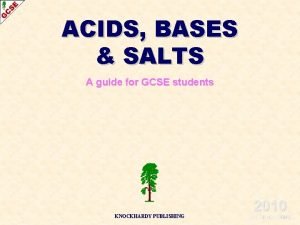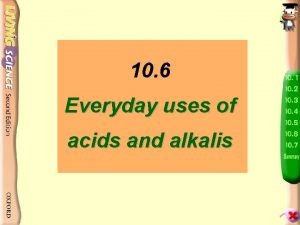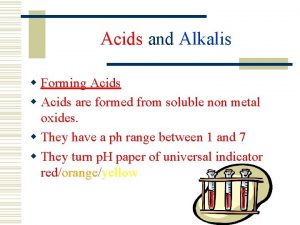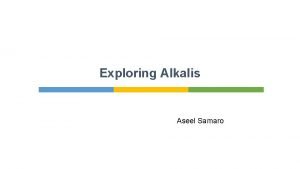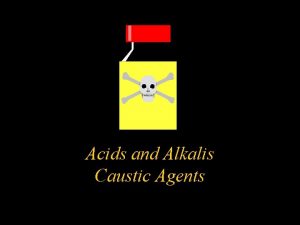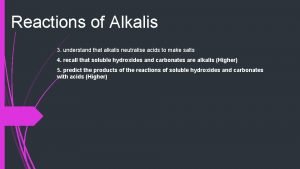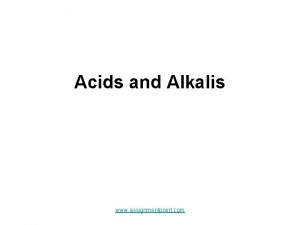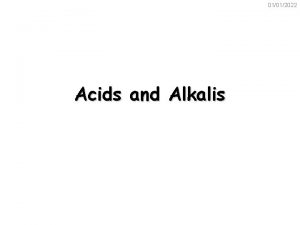Chemistry 2 Acids and alkalis Learning outcomes Acids






- Slides: 6

Chemistry 2 Acids and alkalis • • • Learning outcomes • Acids react with some metals to produce salts and hydrogen. Hydrochloric acid produces chlorides and sulfuric acid produces sulfates. The test for hydrogen uses a burning splint held at the open end of a test tube of the gas. Hydrogen burns rapidly with a pop sound. Acids are neutralised by alkalis (e. g. sodium hydroxide) and bases (e. g. insoluble metal oxides) to produce salts and water. Acids are neutralised by carbonates to produce salts, water and carbon dioxide. Carbon dioxide turns lime water milky. Salt solutions can be crystallised to produce solid salts. 1. 2. 3. 4. 5. 6. How can I recognise acids from alkalis? Why is neutralisation useful? How do acids affect metals? How do acids affect carbonates? How do acids affect metal oxides? Who can make the biggest crystal? • • © Hodder & Stoughton 2017

Chemistry 2 Chemistry and energy Learning outcomes • • Some reactions transfer energy to the surroundings so the temperature increases. Such reactions include combustion, oxidation and neutralisation. Other reactions take in energy from the surroundings so the temperature decreases. These reactions include dissolving ammonium chloride in water and reacting citric acid with sodium hydrogencarbonate. 1. What chemicals work well in self-heating cans? 2. What’s the best cooling mixture? © Hodder & Stoughton 2017

Chemistry 2 Speeding up • Learning outcomes The rate of a chemical reaction may be increased by: − increasing the temperature − increasing the concentration of the reactants − increasing the surface area of solid reactants − adding a suitable catalyst. 1. How can I speed up the dissolving of calcium carbonate? 2. How does temperature affect reaction rate? 3. Why are catalysts useful? © Hodder & Stoughton 2017

Chemistry 2 Fuel and fires • Learning outcomes • • • Some reactions transfer energy to the surroundings so the temperature increases. Such reactions include combustion, oxidation and neutralisation. Crude oil is a mixture of a very large number of compounds. Crude oil is found in deposits underground, e. g. the oil fields under the North Sea. Crude oil may be separated into fractions by distillation. This process, which takes place in a refinery, can be used to produce a range of useful fuels and oils, including petrol and diesel. When fuels burn completely, the gases released into the atmosphere include carbon dioxide, water (vapour) and oxides of nitrogen. Sulfur dioxide is also released if the fuel contains sulfur. When fuels burn in a limited supply of air, carbon monoxide is produced. Solid particles (soot) may also be produced. Oxides of nitrogen and sulfur dioxide cause acid rain and problems for human health. Carbon monoxide is a colourless, odourless, poisonous gas that can cause death. Solid particles can cause global dimming and problems for human health. 1. 2. 3. 4. 5. 6. What burns? How can I extinguish fires safely? What does combustion produce? What does the best chimney look like? How do oil refineries work? What poisonous gases does combustion produce? • • © Hodder & Stoughton 2017

Chemistry 2 Air and water • • 1. 2. 3. 4. Learning outcomes During the first billion years of the Earth’s existence, there was intense volcanic activity that released gases, which formed the early atmosphere and water vapour that condensed to form the oceans. The early atmosphere was mainly carbon dioxide with little or no oxygen. From about 3 billion years ago, algae and plants developed and produced the oxygen that is now in the atmosphere, by a process called photosynthesis. Photosynthesis can be represented by the word equation carbon dioxide + water → glucose + oxygen Carbon dioxide was removed from the early atmosphere by dissolving in the oceans and by photosynthesis. Most of the carbon from the carbon dioxide gradually became locked up in rocks as carbonates and fossil fuels. How do green plants make oxygen? Global warming and the greenhouse effect − fact or fantasy? What makes it rain? Is bottled water worth the cost? © Hodder & Stoughton 2017

Chemistry 2 Air and water • • • 1. 2. 3. 4. Learning outcomes The Earth’s atmosphere is now about four-fifths (80%) nitrogen and about one fifth (20%) oxygen, with small amounts of other gases, including carbon dioxide, water vapour and argon, which is a noble gas. Some human activities increase the amounts of greenhouse gases in the atmosphere, such as carbon dioxide from burning fossil fuels and methane from landfill and cattle farming. Increased levels of greenhouse gases in the atmosphere cause the temperature to increase. Many scientists believe that this will result in global climate change. Water that is safe to drink has small amounts of dissolved substances and low levels of microbes. Most drinking water is produced by choosing a suitable source of fresh water, filtering to remove solids and sterilising to kill microbes. Water can be separated from salty water by distillation, which requires a large energy input. How do green plants make oxygen? Global warming and the greenhouse effect − fact or fantasy? What makes it rain? Is bottled water worth the cost? © Hodder & Stoughton 2017
